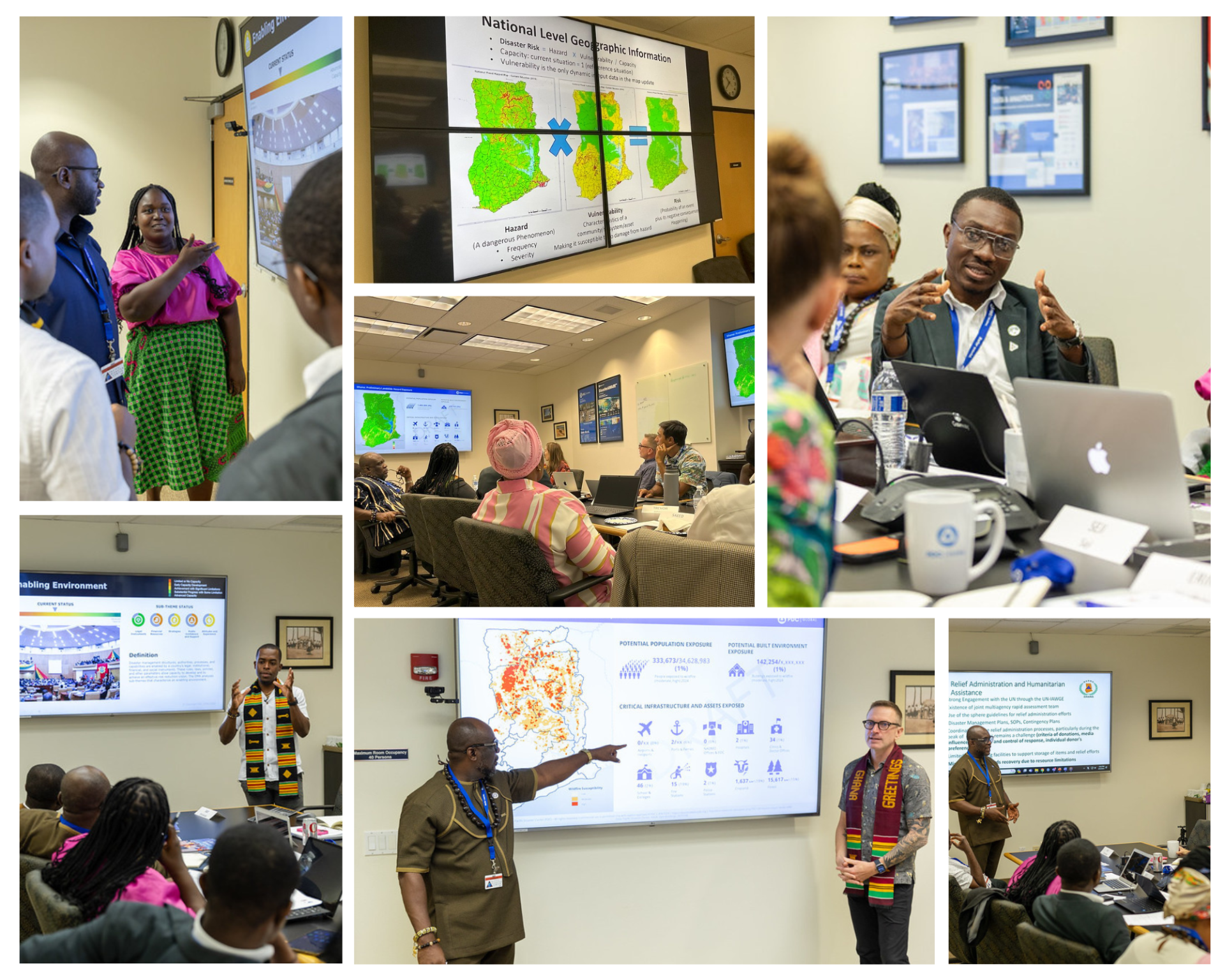
Kihei, Hawaii–The Pacific Disaster Center (PDC) Hosts Bilateral Exchange with Ghana’s National Disaster Management Organization (NADMO)
The Pacific Disaster Center (PDC), an applied science and research center based in Maui and affiliated with the University of Hawaiʻi, hosted a bilateral exchange with a delegation of nine disaster management experts from Ghana’s National Disaster Management Organization (NADMO) from April 8-12, 2024.
Collaboration on National Disaster Preparedness Baseline Assessment
The exchange was part of an ongoing collaboration between PDC and Ghana on its National Disaster Preparedness Baseline Assessment. Both Maui and Ghana are facing increasing impacts from extreme rains and fires, making it crucial to address the vulnerabilities and resilience of communities. The exchange aimed to learn from collective experiences and strengthen disaster management efforts.

Climate Disasters in Maui and Ghana
In 2023, both Maui and Ghana experienced historic climate disasters. Maui faced deadly wildfires in the drought-stricken town of Lahaina, resulting in the loss of lives and displacement of residents. Ghana’s Akosombo Dam was at risk of failure due to unprecedented rainfall, leading to a controlled dam spillage event that displaced thousands of people and caused widespread destruction downstream.

Focus on Sustainable Development Goals (SDGs)
Both Maui and Ghana face catastrophic impacts from wildfires and flooding. The exchange aimed to address the vulnerabilities and resilience of communities, aligning with the Sustainable Development Goals (SDGs) set by the United Nations. By sharing experiences and best practices, the stakeholders aimed to improve disaster risk reduction efforts and build stronger partnerships.
Key Quotes
Director General of Ghana’s NADMO, Hon. Eric Nana Agyemang-Prempeh:
“Climate change exposed Ghana to prolonged rainfall which led to the dam spillage of 2023. Over 80,000 individuals were affected due to the overflow of river bodies upstream and the impact of the dam spillage. The affected population includes different demography of vulnerable groups including persons with special needs. I am delighted to be present here at the Pacific Disaster Center headquarters, not only in the spirit of institutional solidarity but mainly for the opportunity to identify best practices towards disaster risk reduction.”
PDC’s Executive Director Ray Shirkhodai:
“The disasters our communities are contending with are just two among dozens of catastrophes that inflicted suffering for millions of people in 2023. The increase in frequency and severity of climate-related disasters underscores the need for improved risk assessments, advanced early warning systems, and partnership-based resilience-building efforts worldwide.”
Collaboration on National Disaster Preparedness Baseline Assessment
The weeklong engagement included a review and collaboration on the preliminary final results from Ghana’s National Disaster Preparedness Baseline Assessment. The assessment utilized PDC’s advanced data science, historical hazard data, and climate models to identify risks, vulnerabilities, and coping capacities in Ghana. The partnership aimed to improve disaster management frameworks and align with national priorities and the UN’s 2030 goals.

Integration of PDC’s Data and Products
PDC’s data and products supported response efforts in Maui after the wildfires, providing early impact estimates and real-time updates for multiple responding agencies. Similar capabilities are now available to Ghana through the partnership with PDC and the integration of
SDGs, Targets, and Indicators
1. Sustainable Development Goal: Goal 11 – Sustainable Cities and Communities
- Target 11.5: By 2030, significantly reduce the number of deaths and the number of people affected and substantially decrease the direct economic losses relative to global gross domestic product caused by disasters, including water-related disasters, with a focus on protecting the poor and people in vulnerable situations.
- Indicator: Number of deaths, missing persons, and directly affected persons attributed to disasters per 100,000 population.
2. Sustainable Development Goal: Goal 13 – Climate Action
- Target 13.1: Strengthen resilience and adaptive capacity to climate-related hazards and natural disasters in all countries.
- Indicator: Number of countries that have integrated mitigation, adaptation, impact reduction, and early warning into their national policies, strategies, and planning.
3. Sustainable Development Goal: Goal 17 – Partnerships for the Goals
- Target 17.17: Encourage and promote effective public, public-private, and civil society partnerships, building on the experience and resourcing strategies of partnerships.
- Indicator: Number of countries reporting progress in multi-stakeholder development effectiveness monitoring frameworks that support the achievement of the sustainable development goals.
Analysis
1. The SDGs addressed or connected to the issues highlighted in the article are Goal 11 (Sustainable Cities and Communities), Goal 13 (Climate Action), and Goal 17 (Partnerships for the Goals).
2. Specific targets under those SDGs based on the article’s content are:
– Target 11.5: By 2030, significantly reduce the number of deaths and the number of people affected and substantially decrease the direct economic losses relative to global gross domestic product caused by disasters, including water-related disasters, with a focus on protecting the poor and people in vulnerable situations.
– Target 13.1: Strengthen resilience and adaptive capacity to climate-related hazards and natural disasters in all countries.
– Target 17.17: Encourage and promote effective public, public-private, and civil society partnerships, building on the experience and resourcing strategies of partnerships.
3. The indicators mentioned or implied in the article that can be used to measure progress towards the identified targets are:
– Number of deaths, missing persons, and directly affected persons attributed to disasters per 100,000 population.
– Number of countries that have integrated mitigation, adaptation, impact reduction, and early warning into their national policies, strategies, and planning.
– Number of countries reporting progress in multi-stakeholder development effectiveness monitoring frameworks that support the achievement of the sustainable development goals.
Table: SDGs, Targets, and Indicators
| SDGs | Targets | Indicators |
|---|---|---|
| Goal 11 – Sustainable Cities and Communities | Target 11.5: By 2030, significantly reduce the number of deaths and the number of people affected and substantially decrease the direct economic losses relative to global gross domestic product caused by disasters, including water-related disasters, with a focus on protecting the poor and people in vulnerable situations. | Number of deaths, missing persons, and directly affected persons attributed to disasters per 100,000 population. |
| Goal 13 – Climate Action | Target 13.1: Strengthen resilience and adaptive capacity to climate-related hazards and natural disasters in all countries. | Number of countries that have integrated mitigation, adaptation, impact reduction, and early warning into their national policies, strategies, and planning. |
| Goal 17 – Partnerships for the Goals | Target 17.17: Encourage and promote effective public, public-private, and civil society partnerships, building on the experience and resourcing strategies of partnerships. | Number of countries reporting progress in multi-stakeholder development effectiveness monitoring frameworks that support the achievement of the sustainable development goals. |
Behold! This splendid article springs forth from the wellspring of knowledge, shaped by a wondrous proprietary AI technology that delved into a vast ocean of data, illuminating the path towards the Sustainable Development Goals. Remember that all rights are reserved by SDG Investors LLC, empowering us to champion progress together.
Source: pdc.org

Join us, as fellow seekers of change, on a transformative journey at https://sdgtalks.ai/welcome, where you can become a member and actively contribute to shaping a brighter future.

